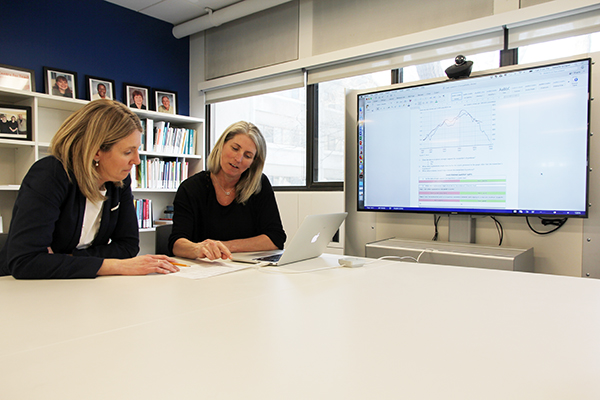Learning Outcomes Assessment project into new phase
February 28, 2018
Share

During their undergraduate years, students are busy mastering their course curriculums. But there is a growing focus across the university on ensuring their critical thinking, creative thinking, and problem solving skills are also being put to the test at every opportunity. These transferable skills are what employers are interested in, and can really help when students get out into the job market.
This is where the ongoing Learning Outcomes Assessment project at Queen’s comes in. It’s funded by the Higher Education Quality Council of Ontario (HEQCO) and has now entered a new phase with the launch of the Cognitive Assessment Redesign (CAR) initiative.
“This initiative is aimed at taking into account everything we have learned so far about how to measure and embed more cognitive thinking skills into undergraduate courses,” says Jill Scott, Vice Provost (Teaching and Learning). “It also provides our faculty with support to increase their capacity to specifically develop and assess transferable higher-order skills.”
To get things started, instructors from 25 first and fourth year courses expressed interest in redesigning assignments materials to support student skill development. The courses from several different faculties each received a $5,000 grant to fund the modification or improvement of their courses. Each was also paired with an assessment facilitator with expertise in their area to help them align their assessments to a set of standardized rubrics.
A rubric is essentially a tool for teachers that defines and describes what is expected for a specific level of achievement. Queen’s has settled on a set of standardized rubrics that articulate four levels of achievement, aimed at the demonstration of skills from first to fourth year undergraduate education.
“As the research is showing, one of the best ways to measure a student’s ability to apply knowledge or skills as they would in the real world is to embed critical thinking and problem solving challenges into their regular course work and then assess it as part of their mark,” says Brian Frank, Associate Dean (Teaching and Learning) and co-Principal Investigator along with Dr. Scott. “The important part is ensuring the standardized rubrics are being applied by all instructors in the same way so we can gather reliable data and thereby get a clearer picture of how much our students are typically improving during their undergraduate years at Queen’s.”
As part of this rollout, teaching assistants working with participating instructors are also being specially trained to score assignments that align with the standardized rubrics. This will ensure they are all marking consistently across a course that has quite a few students and quite a few teaching assistants.
“For students, this new way of designing authentic assignments or assessments has a lot of benefits. When they receive the rubrics up front it helps them figure out what they need to demonstrate to receive top marks on the assignment. They can also then compare their eventual mark to the rubric to see where they can improve,” says Natalie Simper, Assessment Research Project Manager in the Centre for Teaching and Learning.
“Instructors are reporting students are appreciating the clearer direction the rubrics provide and have fewer questions both during and after their assignments.”
Along with this authentic assignment work, a selection of students in first and fourth year are also writing a standardized test this year. The ETS HEIgthen assessment also aims to measure the students’ ability to both analyze and synthesize complex information.
“So far about 1,500 students have written the test this year. We have developed methods to effectively compare the first and fourth year group’s test results so we can quantify the difference. These results support the validity of rubric evaluation of the authentic assignments,” says Ms. Simper.
Queen’s is one of seven universities and colleges in the Learning Outcomes Assessment Consortium created by HEQCO in December 2012. The organization will soon publish the results from the first phase of the Learning Outcomes Assessment project completed last year at Queen’s. As for next steps, the program has received the green light for the 2018-19 academic year to ensure the initiative can continue to grow.
“Overall, our aim in this phase is to create a hub or network of instructors and facilitators who are able to share their expertise in cognitive assessment redesign with their colleagues. This way the work will begin to spread organically for the benefit of students and instructors alike,” says Dr. Scott. “Most people at Queen’s have likely never been part of a project like this before and it can change how you think about your role or practice as a teacher. It is a different way to think about assessment but it’s quite invigorating to apply fresh techniques and new knowledge to the educational work we all believe in.”
For more information on the CAR initiative or the overall project, visit the Learning Outcomes Project webpage or contact natalie.simper@queensu.ca.